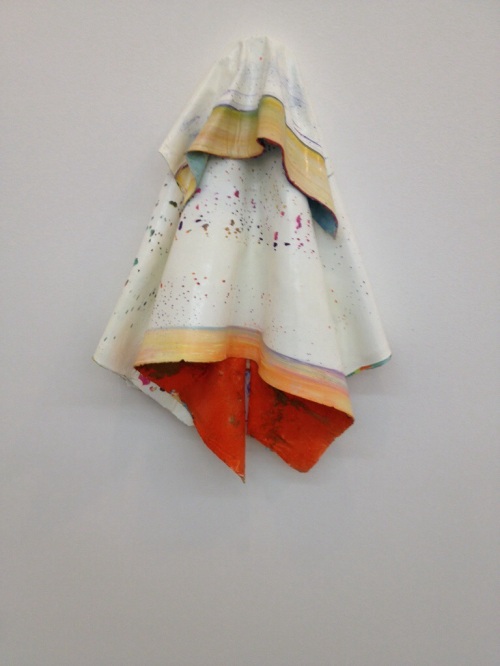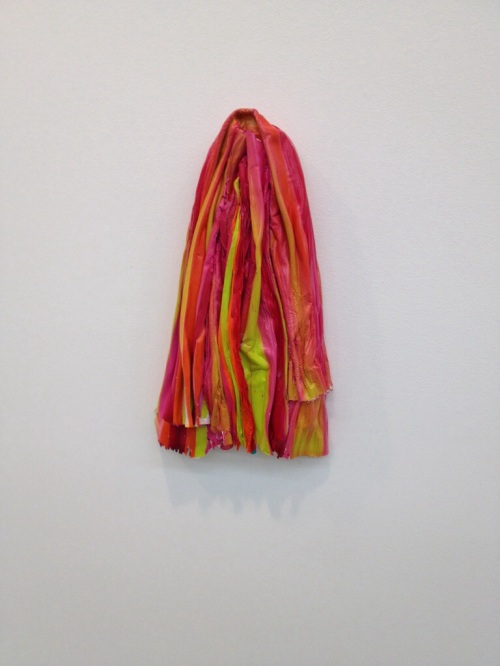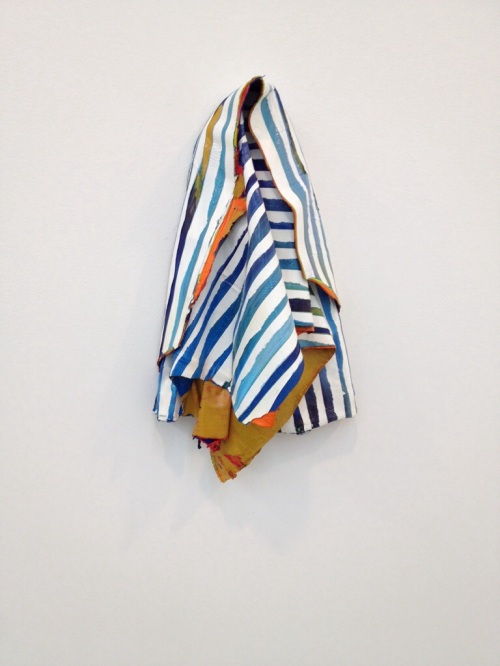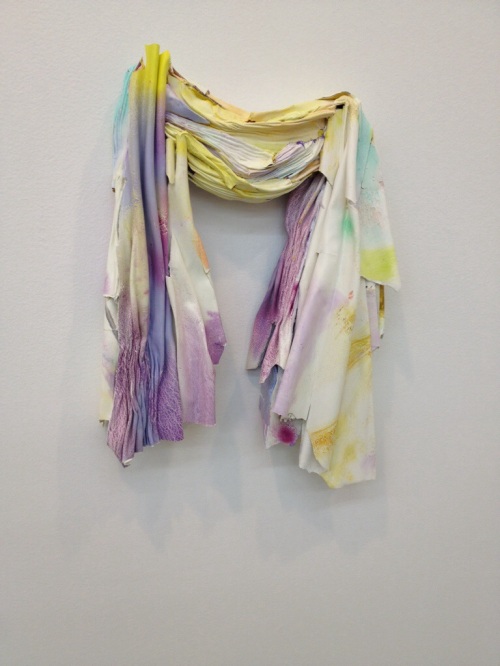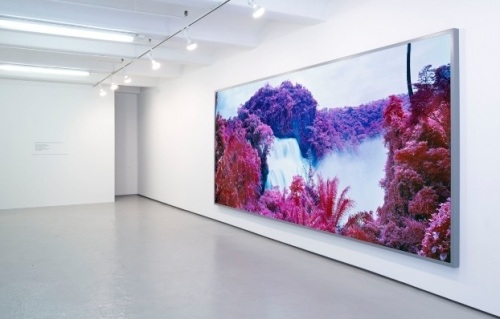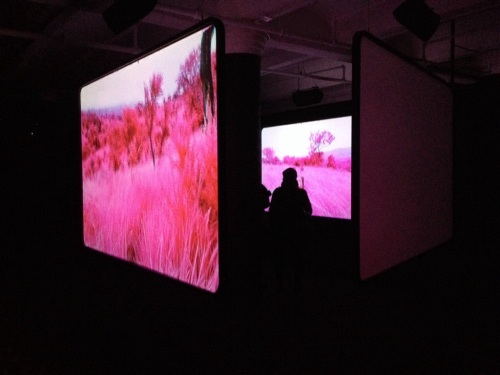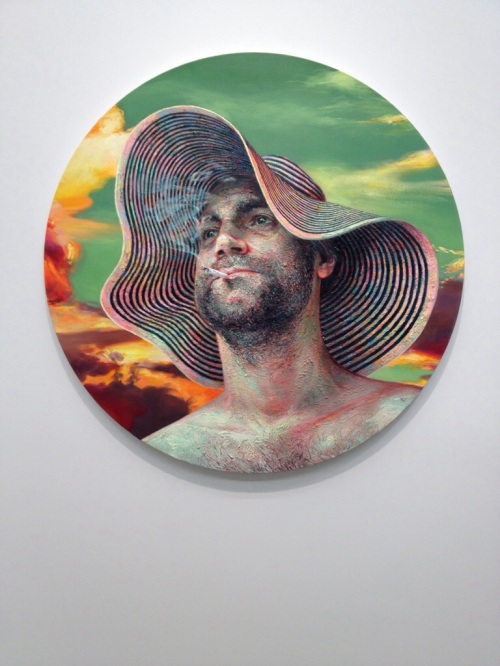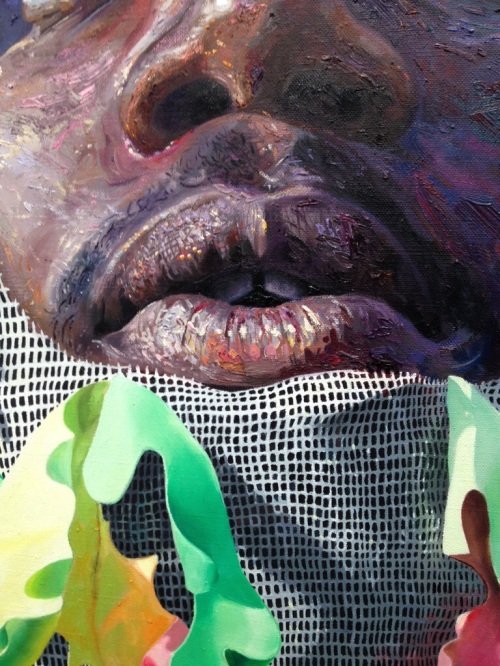Leslie Wayne @ Jack Shainman
Leslie Wayne manipulates the medium of painting by approaching oil paint as a sculptural material, often times scraping, folding, cutting, and building up the surfaces. Her work takes on three-dimensional forms with layers, varying textures, and colors. She said in a recent interview with Stephanie Buhmann “color and form are one and the same in my painting, which is what defines so much of their character.” The tactile quality of her work evokes the experience of geology and natural phenomena. “My relationship to landscape is really rooted in memory, in the light, colors and geography of the West,” she said in an interview published in Figure/Ground Communication in 2013. She continues “So here, in the middle of midtown Manhattan, I approach the subject more as an opportunity to depict visual manifestations of physical forces: compression, subduction, morphogenesis, rather than pictures of nature in the traditional sense. And many of the paintings are shaped in ways that accentuate movement and instability.”
Filed under: Uncategorized | Leave a Comment
Richard Mosse @ Jack Shainman
Richard Mosse: The Enclave is the culmination of Mosse’s work in eastern Democratic Republic of Congo.
Mosse was drawn to eastern Congo because of the inherent problems of representing its cancerous cycle of war. Struck by the absence of a concrete trace of the conflict on the landscape, Mosse documented rebel enclaves and sites of human rights violations in a way which attempts to overturn traditional realism, and see beneath the surface.
Using an extinct type of infrared film once employed by the military to detect camouflaged installations from the air, Mosse renders ‘The Heart of Darkness’ in irradiating Technicolor. With a significantly slower life than images constructed by photojournalism, Mosse’s highly aesthetic approach considers problematic imagery from an oblique angle that strategically allows a different temporality in seeing.
Mosse embraces the infrared medium’s subtle shift in wavelength in an attempt to challenge documentary photography, and engage with the unseen, hidden and intangible aspects of eastern Congo’s situation – a tragically overlooked conflict in which 5.4 million people have died of war related causes since 1998.
To produce The Enclave, Mosse worked with the cinematographer Trevor Tweeten to evolve a style of long tracking shot made with Steadicam, resulting in a spectral, disembodied gaze shot on 16mm infrared film. The piece’s haunting, visceral soundscape is layered spatially by eleven point surround sound, composed by Ben Frost from recordings gathered in North and South Kivu.
The Enclave comprises six monumental double-sided screens installed in a large darkened chamber creating a physically immersive experience. This disorienting and kaleidoscopic installation is intended to formally parallel eastern Congo’s multifaceted conflict, confounding expectations and forcing the viewer to interact spatially from an array of differing viewpoints. The Enclave is an experiential environment that attempts to reconfigure the dictates of photojournalism and expanded video art.
Mosse was born in 1980 in Ireland and is based in New York. He earned a Postgraduate Diploma in Fine Art from Goldsmiths, London in 2005 and an MFA in Photography from Yale School of Art in 2008. He currently has a solo exhibition at the Royal Hibernian Academy in Dublin, Ireland, which will travel to Ormston House Gallery, Limerick City, Ireland, and has upcoming solo exhibitions at FOAM, Amsterdam, the Netherlands; the University of New South Wales, Sydney, Australia; Fotomuseum, Antwerp, Belgium; Centro Atlántico de Arte Moderno, Canary Islands, Spain; the Vinyl Factory, London, England; and DHC/Art, Montreal, Canada. Forthcoming group shows include The Sensory War 1914–2014, Manchester Art Gallery, England; Landscape, Museo di Arte Moderna e Contemporanea di Trento, Italy; Counter Intelligence, Justina M. Barnicke Gallery, University of Toronto, Canada; and Contingency Plans, Shanghai Study Center, China.
Mosse has been nominated for the prestigious Deutsche Boerse Prize and will be included in an exhibition of the short listed artists at the Photographer’s Gallery, London, England in April, 2014, which will travel to Deutsche Boerse Headquarters, Frankfurt, Germany later that year. Mosse is a recipient of Yale’s Poynter Fellowship in Journalism (2014), the B3 Award at the Frankfurt Biennale (2013), an ECAS Commission (2013), the Guggenheim Fellowship (2011), and a Leonore Annenberg Fellowship (2008-2010). Foreign Policy Magazine listed Mosse as a Leading Global Thinker of 2013.
Filed under: Uncategorized | Leave a Comment
Do Ho Suh @ The Armory Show
Do-Ho Suh was born in Seoul, Korea, in 1962. After earning his BFA and MFA in Oriental Painting from Seoul National University, and fulfilling his term of mandatory service in the South Korean military, Suh relocated to the United States to continue his studies at the Rhode Island School of Design and Yale University.
About The Artist
Through architecture and narrative, South Korean artist Do Ho Suh’s intricate sculptures and installations define and re-define the notion of identity and individuality, public and private space. Having moved from South Korea to the United States, Suh’s investigation—and in particular the notion of “infinite movability” of space and unconventional notions of scale and site-specificity—developed around his personal experiences of cultural displacement and struggle with cultural identity.
These tensions—rootedness versus displacement and individuality versus conformity—are seen in seminal works like Seoul Home/L.A. Home, 1994, a transparent baldachin of silk shaped like a house suspended from the ceiling, a “house” that can be folded up and packed into a suitcase. Additionally, works like Floor, 1997—2000, where the small palms of hundreds of multicolored figures hold up a thick, glass platform; Who Am We?, 1996, where the tiny portraits of approximately 40,000 teenagers taken from the artist’s high-school yearbooks are made into pixilated-looking wallpaper, the portraits only visible at close distance; and Fallen Star 1/5, 2009, a 1/5 scale model of a house the artist lived in Providence, Rhode Island, crashing into the traditional Korean house (called hanok) that the artist grew in, are also prime examples of materials, themes, and subjects in Do Ho Suh’s oeuvre to date.
Filed under: Uncategorized | 1 Comment
Internationally renowned artist Judy Pfaff is one of the pioneers of installation art. She combines aspects of sculpture, painting, and architecture to form dynamic works that transcend aesth-etic boundaries. Her recent paper-based works, which incorporate motifs derived from the natural world, are unique in both process and form, combining traditional and non-traditional techniques and materials. Pfaff will be working on-site for her exhibition at the Weatherspoon Art Museum.
Judy Pfaff (b. 1946, London, England) earned a BFA from Washington University, St. Louis, and an MFA from Yale University. She received the prestigious John D. and Catherine T. MacArthur Foundation Award in 2004 and fellowships from the John Simon Guggenheim Memorial Foundation (1983) and the National Endowment for the Arts (1986). She has had major exhibitions at the Elvehjem Museum of Art, University of Wisconsin, Madison (2002); Denver Art Museum (1994); St. Louis Art Museum (1989); and Albright-Knox Art Gallery, Buffalo (1982). She represented the United States in the 1998 São Paolo Biennial.
For more info check out: http://weatherspoon.uncg.edu/exhibitions/show/?title=judy-pfaff-falk-visiting-artist
Filed under: Uncategorized | Leave a Comment
Catherine Ross works in video, framing instances that often go unnoticed in their original context. Isolating the movements of humans and/or objects, her videos create new sequences that reveal an inseparable relationship between motion and sound. Here she finds that movement reveals an inherent awkwardness, a humor that echoes our own vulnerabilities.
“Closed Circuit”
Beautifully shot in Hi-definition video, Closed Circuit is visually reminiscent of the set of a late 1960’s television program. The location is a home that is an actual current residence in which neither furniture nor objects have been moved from their original resting place in 40 years. In Closed Circuit a rotary telephone flies in an endless loop around the house, exploring and seemingly searching for a spot to settle, but never finds one. The music composed by Taylor Haskins gives a feeling that something is about to happen, but it never quite does.
Inspired by the opening sequences from the pilot of the television show “Columbo” in which a musical score guides you through a crime being committed, Closed Circuit surveils a similarly visually lush environment (as was common to this program), but steers without a plot. Closed Circuit places the viewer suspended in time and simultaneously moving forward as he follows the path of the phone. The video uses an endless loop, both visually and musically, to create a simple form that reveals its complexity through repetition, rather than a defining moment. The title Closed Circuit refers to the loop, while also calling to mind television surveillance systems that document without a human presence.
To see more of her work visit http://www.catherineross.net
Filed under: Uncategorized | Leave a Comment
The artwork of Travis Graves is rooted in addressing notions of expectation and cultural attitudes as it defines our relationship to the natural world. He is interested in the relationship between nature / culture as well as society’s dependence on nature, and its influence over it.
“Often our attitudes and practices set us off balance with nature as we continue to indifferently stumble along with little regard for the resulting consequences. With this in mind, I find myself drawn to the manipulation of natural materials as a metaphor for society’s dependence on nature and ultimately its influence over it. My choice of familiar materials and subjects, clearly reference the natural world while simultaneously invoking their cultural identity. In doing so I look to point out the obvious, yet often ignored connections that exist between the natural world and the cultural attitudes we project on it.” – Travis Graves
Filed under: Uncategorized | Leave a Comment
Up now!
TYRONE GETER: Purgatory Ain’t Nothin’ But The Blues
Sumter County Gallery of Art is excited to present a ‘capstone’ exhibition of Tyrone Geter’s allegorical “Purgatory Ain’t Nothin’ But The Blues”. This series of numerous large-scale assemblages, drawings, paintings and mixed media pieces are rarely displayed as a whole due to space constraints.
Geter observes about Purgatory: The body of work in the exhibition, “Purgatory Ain’t Nothin’ But The Blues” encompasses the need and desire of the human spirit to strive for perfection amidst a fast paced world of entanglement, discourse, globalization and contradictions of today’s society.
The use of paints, charcoal, wood, twigs, clay, metal, plastic, cloth and torn paper enabled me to also combine two dimensional with three dimensional, realism with abstractions to harmoniously engage the viewer in a visual dialogue. Hopefully, anyone who has had a personal dialogue with the blues, felt its overbearing weight and the cold, harsh embrace of its touch will be able to follow the parallel path to Purgatory. It is my hope that after the “Purgatory walk” in the gallery, the viewers will leave with the belief that there is always light at the end of the tunnel, and that Inner peace begins with self, even in the midst of chaos.
Tyrone Geter was born in Anniston, Alabama. He received Masters of Fine Art from Ohio University, Athens, OH majoring in painting. He taught at Ahmadu Bello University, Zaria, Nigeria, and at the University of Akron’s School of Art. Geter is currently Associate Professor of Art, and Director of the Ponder Fine Arts Gallery at Benedict College, Columbia, SC
Geter has been in many solo and group exhibitions including, Purgatory Ain’t Nothin’ But The Blues, Univ of Akron, Akron, OH, 2009; State Art Collection: The African American Voice, Clemson Univ. Arts Center, 2008; Thresholds: Art and Spiritual Life traveling exhibition sponsored by South Carolina Arts Commission, 2003; Piccolo Spoleto Festival, Charleston, SC, 2002, and Elder Art Gallery, Charlotte, NC, 2002.
South Carolina Triennial 2001, South Carolina State Museum, Columbia, SC; Moja Arts Festival, Charleston, SC; Taft Museum, Cincinnati, OH; Hampton Institute Museum, Hampton, VA; Atrium Gallery, NY; Isobel Neal Gallery, Chicago, IL;
Geter has also been recognized internationally having his artwork exhibited in the the United Kingdom, Nigeria, Senegal, Japan, and China.
Selected Awards Include:
Mural commission for the new Freedom Center in Cincinnati OH; 2001 Individual Artist award, Tanne Foundation, First Place Moja Festival, Charleston, SC 2001; Moja Festival, Charleston, SC 2000 First Place and Best of Show; Akron Art Museum; Individual Artist Grant, Ohio Arts Council, Columbus, OH; The Butler Institute of American Art, Youngstown, OH, First Place in painting; The Robert Duncanson Award at the Taft Museum, Cincinnati OH; Artist Fellowship Grant, Foundation for the Arts and Humanities, Boston, MA; American Book Sellers Pick of the List – 1996 Illustrated Book.
Tyrone Geter has illustrated 10 children’s books. His most recent is “A Change of Plans.”
Geter’s Artist Statement:
My mother once told me “sometimes she felt like she didn’t have no life.” That statement made with so much honesty, conviction, and passion yet free of even a hint of self-pity has throughout my career been one of the guiding principles of not only how I live my life, and relate to other people, but has also profoundly influenced the philosophy of my art In the early 1900 hundreds when she grew up, life was “the” struggle. Survival was day-to-day and filled with the perils of discrimination, poverty, illiteracy and a host of other dangers inherited from a lifetime of being poor, black and under educated. She survived and passed her legacy of love, compassion, hope and a sense of “doing the right thing” on to her children.
My work finds its foundation in that legacy. It refers to the trials of youth and the struggle of the aged. It seeks to speak to and for those with no voice. My work is compassion, hope, justice, and perseverance, things I learned from my mother.
Filed under: Uncategorized | Leave a Comment
Rally for the Arts Commission!
“BREAK THE DEAL!”
“BREAK THE DEAL!”
LEGISLATORS STILL HAVE A CHOICE
TO DO THE RIGHT THING!
THE STORY BEHIND THE BUDGET DEAL
AND THE GOVERNOR’S VETOES
Dear Arts Supporters:
One legislator has been forthright in telling his constituents why next week, the Governor’s vetoes will be sustained unless we can get our legislators to ‘BREAK THE DEAL”. We thought you would want to know this important information. Please read the following from House Majority Leader, Representative Kenny Bingham (R-Lexington Co.):
“In the House of Representatives, our first try to pass the final budget conference report, failed by a vote of 47 to 69. After several days of intense negotiations, we were finally able to pass the budget, but only by the slimmest of margins and without any help from the House Democrats. This set the stage for what we now have before us. As a result of not having the support of House Democrats throughout this years budget process, this allowed the Governor and a group of his closest allies, to hold us hostage with this year’s budget. We were faced with the dilemma of either agreeing to accept his line item vetoes, or he was going to veto the entire budget document which would have required that we start the budget process over from scratch. A process that took 5 months to complete the first time, and one that would have been next to impossible to complete prior to government having to shut down on July 1st.
Therefore, when the House Democrats informed us on the last day of session that they would not help us override the Governor’s veto of the entire budget, we were left with no other real option but to agree to sustain the Governor’s line item vetoes. While this is clearly not the kind of news that I hoped to be sending you, it is unfortunately the truth. So barring the Governor having a change of heart, or some other unforeseen circumstance, I anticipate that the Governor’s vetoes will be sustained.”
WE CAN BREAK THIS DEAL!
THIS IS THE LAST BILL THAT WILL EVER CROSS OVER GOVERNOR SANFORD’S DESK. THE VETO MONEY THAT IS SLASHED FROM THE ARTS COMMISSION (#32 & #105) AND ANY OTHER AGENCY, WILL NOT BE RE-DIRECTED TO ANY OTHER AGENCY, PROGRAM OR SERVICE. THE BUDGET PROCESS IS COMPLETE AND WAS BALANCED, VOTED ON, AND PASSED BY THE HOUSE & SENATE. THESE VETO CUTS DON’T HELP ANYONE – BUT THEY DO HURT THE ARTS! THEREFORE, THESE LEGISLATORS HAVE NOTHING TO LOSE AND MUCH TO GAIN BY BREAKING THE DEAL AND OVERRIDING THE GOVERNOR’S VETOES. OUR LEGISLATORS WORK FOR YOU! LET YOUR VOICE BE HEARD!
IF YOU FEEL THAT THE ARTS ARE IMPORTANT TO YOU, YOUR COMMUNITY AND OUR SCHOOLS, CONTACT YOUR LEGISLATORS AND TELL THEM TO “BREAK THE DEAL”. CONTACT YOUR HOUSE MEMBERS IMMEDIATELY AND THEN YOUR SENATORS – in your home district or in Columbia BY TUESDAY! Even if you have already contacted your legislator, you may want to contact them again with this new information, asking them to BREAK THE DEAL!
OVERRIDE VETO #32 & VETO #105
Governor Mark Sanford has issued vetoes that will decimate the South Carolina Arts Commission and state arts funding as we know it! Veto #32 cuts “Statewide Arts Services” totaling $1,212,733 – a little over HALF of the Arts Commission’s budget. This funding represents their budget for programs, services, grants and related personnel, leaving the agency but a shell of itself with no ability to carry out its mission and undermining 40 years of work as the catalyst of arts funding and services in our state. This funding also includes arts education – such as the nationally recognized Arts in Basic Curriculum Project (ABC). Veto #105 cuts the $250,000 in stimulus funds for their competitive grants program, which funds local arts programs in communities and school districts in every county of the state. These grants fund arts education, general operating support for local arts organizations and efforts to grow the arts economy of our state through cultural tourism. These drastic cuts will virtually leave the Arts Commission incapable of serving the citizens of this state.
The State Museum is holding a rally at the Statehouse on Tuesday at 11:30 AM. Please feel free to join them and bring your own signage that says something like “Support the Arts – Override Veto 32 and Veto 105” or “Break the Deal!” Override Veto 32 and Veto 105 and support the Arts.”
For contact information of all House and Senate members, go to the Arts Alliance web site: http://www.scartsalliance.net and click 2010 General Assembly Contact List.
If you don’t know who your House or Senate member is, go to http://www.scstatehouse.gov/cgi-bin/zipcodesearch.exe and type in your zip code to bring up your legislator’s contact information.
For contact information on your legislative delegation, go to: http://www.scstatehouse.gov/countydelegationinfo/cntymast.html.
Here is some other helpful information:
House Fax: 803-734-2925
House Ways & Means Phone number (Rep. Dan Cooper’s office) 803-734-3144
Senate Fax: 803-212-6299
Senate Finance Committee Phone number (Senator Hugh Leatherman’s office) 803-212-6640
Please share/forward this email to your colleagues and friends, board member, volunteers, affiliate organizations, teachers. Share it through your address lists, using social media outlets like Facebook and Twitter. This is a case where NUMBERS MATTER!
If you believe in the work of the South Carolina Arts Alliance, please support our work with your 100% tax deductible contribution at:
http://www.scartsalliance.net/membership/membership-application/ . THANK YOU!
Filed under: Uncategorized | Leave a Comment
